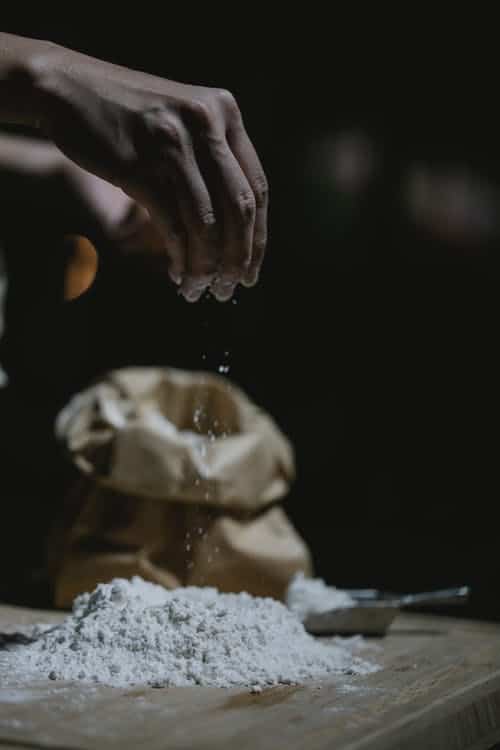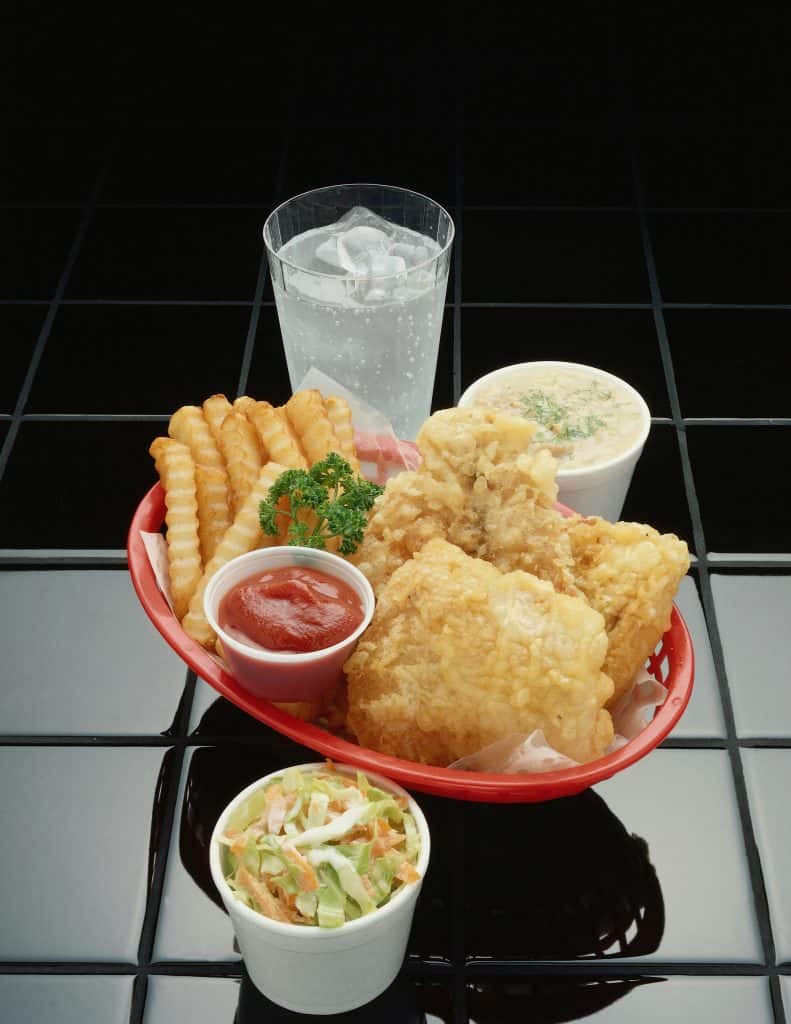As an Amazon Associate we earn from qualifying purchases.
The perfect dredging can produce a delicious payoff – fried fish that is crisp on the outside and tender and flavorful on the inside. To dredge a fish means to coat it with a dry ingredient lightly.
How to Dredge Fish
Fish is usually dredged in flour before being dipped in egg wash and finished with breadcrumbs. Here’s a quick guide on how to dredge fish.

Step One: Find the Right Dish
Before getting the ingredients together, find a shallow dish that’s wide enough for the fish. Using a pie plate is the right way to go, but if you don’t have one at hand, you could use any dish that’s wide enough.
Many home cooks prefer using a large bag over a dish to dredge meat, fish, and vegetables because they find it a lot easier to do.
Using A Bag Instead of a Dish
With a large food-safe bag, all you have to do is add the flour to the bag and shake or roll the fish in the bag to coat it with flour all over. With a large bag, if the pieces of fish you have are small, you can coat multiple pieces in one go.
However, if your bag is smaller or the pieces are big, it’s best to coat pieces one at a time.
You don’t have to use a plastic bag to do this. If you have paper bags lying around, you can go ahead and use one for dredging fish.
Regardless of what kind of bag you use, though, ensure that it is food-safe. Using the wrong type of plastic bag can be dangerous since the dyes, glues, and other chemicals may get absorbed by the flour and fish.
Step Two: Spread and Season the Flour
Spread flour generously in the dish, and season it with salt and pepper. If you want your fish to taste better and have more flavor, add garlic powder and fresh (or dried) herbs of your choice to the flour.
If you like a little bit of heat in your food, you can add paprika, chili powder, or even chili flakes to give the fish a touch of heat.
Step Three: Dry and Season the Fish
Grab some paper towels and pat the fish off with the towels to absorb excess moisture. Doing this will not make the fish dry.

Seasoning the fish makes it a lot more flavorful than the seasoning in the flour does. Make sure you season the fish with liberal amounts of salt and pepper.
Step Four: Dredge the Fish
Take the fish and drench it in the flour-filled dish (or bag). After the fish is liberally covered with flour, turn the fish over to coat the other side.
Remove the fish from the flour and shake it gently over the dish or the bag. Doing this will remove the excess flour from the fish.
If you forget to shake and pat off the excess flour, the coating will become pasty and gummy when you subsequently give the fish an egg wash and breadcrumb-dip.
After you tap the flour off, the fish should be lightly but completely coated. A light and even coating will ensure that the fish has an appetizing golden-brown appearance and develops a delicious inner layer when fried.
—
Warning!
Dredging fish long before frying is not a good idea. The coating will get soggy, ruining the look of the dish. Always dredge your fish right before you cook it, and remember to tap off the excess flour and discard it.
—
“Dredging” Vs. “Breading”
As mentioned earlier, dredging is lightly coating fish with a dry ingredient like flour.
Dredging is a step in the process of breading. In the breading process, the fish is first coated with flour, given an egg wash, and then covered with breadcrumbs. Some recipes call for the fish to be coated with cornmeal instead of breadcrumbs.
The Importance of Breading
Breading fish makes a big difference to the dish:
- The seasoning in the dredging makes the fish a lot more flavorful.
- The breadcrumb or cornmeal coating keeps the fish from sticking to the pan.
- The crunchy outer coating elevates the flavor of the fish.
- The outer coating and inner dredging seal in the moisture of the fish, preventing it from becoming dry or tough.

Besides fish, you can bread meat like chicken and also vegetables. One cannot make crispy onion rings without breading the rings first.
Frequently Asked Questions
Why Dredge Fish?
The flour creates a thin barrier between the fish and the pan, reducing the probability of the fish sticking to the pan.
It also helps the fish cook more evenly and seals in the moisture in the fish, ensuring that it doesn’t become tough. Furthermore, dredging adds another layer of flavor to the fish and gives it a more enticing texture.
Is There an Alternative to the Egg Wash after Dredging?
Cooking for someone with allergies can seem challenging. According to the American College of Allergy, Asthma, and Immunology, up to 2% of children are allergic to eggs.
Instead of using eggs as a sticking agent, you can make a flax egg by whisking together one tablespoon of flax seeds with two parts of water. Let the mixture stand for five minutes and thicken, and then substitute it for the egg.
Can I Dredge Fish with Almond Flour?
If you’re on a keto diet, you can safely substitute all-purpose wheat flour with almond flour. Not only is it low in carbohydrates, but it’s also more nutrient-rich than most other flours. But bear in mind that almond flour needs more egg wash than wheat flour.
Can I Dredge Fish with Cornstarch?
Dredging with cornstarch is an excellent idea if you like your fried fish extra crispy. A cornstarch dredging also helps the fish hold your flavorful sauces better, and since it absorbs less oil than wheat flour, the dish will have a lower fat content.
Conclusion
Dredging is a simple technique, but there are several ways of doing it. If you think using a bag will make the task easier, use it instead of a pie plate.
The ingredient you dredge it with makes a big difference in the flavor, texture, and even the fat and carb content of the final fare.
With this guide handy, though, you’ll be dredging fish like a cordon bleu cook in no time.
